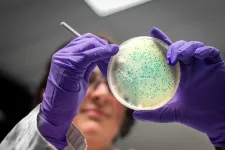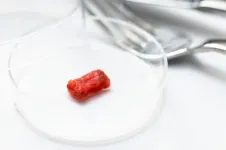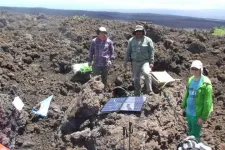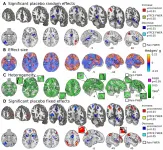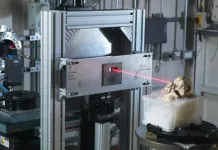(Press-News.org) TROY, N.Y. -- Envisioning an animal-free drug supply, scientists have -- for the first time -- reprogrammed a common bacterium to make a designer polysaccharide molecule used in pharmaceuticals and nutraceuticals. Published today in Nature Communications, the researchers modified E. coli to produce chondroitin sulfate, a drug best known as a dietary supplement to treat arthritis that is currently sourced from cow trachea.
Genetically engineered E. coli is used to make a long list of medicinal proteins, but it took years to coax the bacteria into producing even the simplest in this class of linked sugar molecules -- called sulfated glycosaminoglycans --that are often used as drugs and nutraceuticals..
"It's a challenge to engineer E. coli to produce these molecules, and we had to make many changes and balance those changes so that the bacteria will grow well," said Mattheos Koffas, lead researcher and a professor of chemical and biological engineering at Rensselaer Polytechnic Institute. "But this work shows that it is possible to produce these polysaccharides using E. coli in animal-free fashion, and the procedure can be extended to produce other sulfated glycosaminoglycans."
At Rensselaer, Koffas worked with Jonathan Dordick a fellow professor of chemical and biological engineering, and Robert Linhardt a professor of chemistry and chemical biology. All three are members of the Center for Biotechnology and Interdisciplinary Studies. Dordick is a pioneer in using enzymes for material synthesis and designing biomolecular tools for the development of better drugs. Linhardt is a glycans expert and one of the world's foremost authorities on the blood-thinner heparin, a sulfated glycosaminoglycans currently derived from pig intestine.
Linhardt, who developed the first synthetic version of heparin, said engineering E. coli to produce the drug has many advantages over the current extractive process or even a chemoenzymatic process.
"If we prepare chondroitin sulfate chemoenzymatically, and we make one gram, and it takes a month to make, and someone calls us and says, 'Well, now I need 10 grams,' we're going to have to spend another month to make 10 grams," Linhardt said. "Whereas, with the fermentation, you throw the engineered organism in a flask, and you have the material, whether it's one gram, or 10 grams, or a kilogram. This is the future."
"The ability to endow a simple bacterium with a biosynthetic pathway only found in animals is critical for synthesis at commercially relevant scales. Just as important is that the complex medicinal product that we produced in E. coli is structurally the same as that used as the dietary supplement." said Dordick.
Koffas outlined three major steps the team had to build into the bacteria so that it would produce chondroitin sulfate: introducing a gene cluster to produce an unsulfated polysaccharide precursor molecule, engineering the bacteria to make an ample supply of an energetically expensive sulfur donor molecule, and introducing a sulfur transferase enzyme to put the sulfur donor molecule onto the unsulfated polysaccharide precursor molecule.
Introducing a working sulfotransferase enzyme posed a particularly difficult challenge.
"The sulfotransferases are made by much more complex cells," Koffas said. "When you take them out of a complex eukaryotic cell and put them into E. coli, they're not functional at all. You basically get nothing. So we had to do quite a bit of protein engineering to make it work."
The team first produced a structure of the enzyme, and then used an algorithm to help identify mutations they could make to the enzyme to produce a stable version that would work in E. coli.
Although the modified E. coli produce a relatively small yield -- on the order of micrograms per liter -- they thrive under ordinary lab conditions, offering a robust proof of concept.
"This work is a milestone in engineering and manufacturing of biologics and it opens new avenues in several fields such as therapeutics and regenerative medicine that need a substantial supply of specific molecules whose production is lost with aging and diseases," said Deepak Vashishth, director of the CBIS. "Such advances take birth and thrive in interdisciplinary environments made possible through the unique integration of knowledge and resources available at the Rensselaer CBIS."
INFORMATION:
"Complete biosynthesis of a sulfated chondroitin in Escherichia coli" was published today in Nature Communications with support from National Science Foundation Grant CBET-1604547. Dordick, Linhardt, and Koffas were joined in the research at Rensselaer by Abinaya Badri, Asher Williams, Adeola Awofiranye, Payel Datta, Ke Xia, Wenqin He, and Keith Fraser. Once published, the paper can be found using DOI:10.1038/s41467-021-21692-5.
About Rensselaer Polytechnic Institute
Founded in 1824, Rensselaer Polytechnic Institute is America's first technological research university. Rensselaer encompasses five schools, 32 research centers, more than 145 academic programs, and a dynamic community made up of more than 7,900 students and over 100,000 living alumni. Rensselaer faculty and alumni include more than 145 National Academy members, six members of the National Inventors Hall of Fame, six National Medal of Technology winners, five National Medal of Science winners, and a Nobel Prize winner in Physics. With nearly 200 years of experience advancing scientific and technological knowledge, Rensselaer remains focused on addressing global challenges with a spirit of ingenuity and collaboration. To learn more, please visit http://www.rpi.edu.
Tokyo, Japan - Humans are largely omnivores, and meat in various forms has always featured in the diet of most cultures. However, with the increasing population and pressure on the environment, traditional methods of meeting this fundamental food requirement are likely to fall short. Now, researchers at the University of Tokyo report innovative biofabrication of bovine muscle tissue in the laboratory that may help meet escalating future demands for dietary meat.
With global urbanization, the economics of animal husbandry are becoming unsustainable. From an environmental viewpoint, the land and water costs of modern mega-scale ...
In a world first, an international team of researchers has read an unopened letter from Renaissance Europe - without breaking its seal or damaging it in any way.
The research, published in Nature Communications, describes how an X-ray scanner used in dental research and 'virtual unfolding' allowed the interdisciplinary team to read the contents of a securely and intricately folded letter which has remained unopened for 300 years, while preserving its valuable physical evidence.
A highly sensitive X-ray microtomography scanner, developed at ...
A volcanic eruption in the Galápagos Islands has given scientists a fresh insight into how volcanoes behave and provided vital information that will help to predict future hazards on the islands.
Irish scientists, based at Dublin Institute for Advanced Studies (DIAS) and Trinity College Dublin respectively, were members of an international research team from Ireland, United Kingdom, United States, France and Ecuador that made the discovery.
The research published today (02.03.21) in Nature Communications reveals the first ever detailed description of a volcanic eruption from Sierra Negra - one ...
Hours before the 2018 eruption of Sierra Negra, the Galápagos Islands' largest volcano, an earthquake rumbled and raised the ground more than 6 feet in an instant. The event, which triggered the eruption, was captured in rare detail by an international team of scientists, who said it offers new insights into one of the world's most active volcanoes.
"The power of this study is that it's one of the first times we've been able to see a full eruptive cycle in this detail at almost any volcano," said Peter La Femina, associate professor of geosciences ...
A large proportion of the benefit that a person gets from taking a real drug or receiving a treatment to alleviate pain is due to an individual's mindset, not to the drug itself. Understanding the neural mechanisms driving this placebo effect has been a longstanding question. A meta-analysis published in Nature Communications finds that placebo treatments to reduce pain, known as placebo analgesia, reduce pain-related activity in multiple areas of the brain.
Previous studies of this kind have relied on small-scale studies, so until now, researchers did not know if the neural mechanisms underlying ...
In June 2019, an international team brought the complete skull of the 3.67-million-year-old Little Foot Australopithecus skeleton, from South Africa to the UK and achieved unprecedented imaging resolution of its bony structures and dentition in an X-ray synchrotron-based investigation at the UK's national synchrotron, Diamond Light Source. The X-ray work is highlighted in a new paper in e-Life, published today (2nd March 2021) focusing on the inner craniodental features of Little Foot. The remarkable completeness and great age of the Little Foot skeleton makes it a crucially important ...
Publishing in peer-reviewed scientific journals is crucial for the development of a researcher's career. The scientists that publish the most often in the most prestigious journals generally acquire greater renown, as well as higher responsibilities. However, a team involving two CNRS researchers* has just shown that the vast majority of scientific articles in the fields of ecology and conservation biology are authored by men working in a few Western countries. They represent 90% of the 1,051 authors that have published the most frequently in the 13 major scientific journals in the field since 1945. ...
WASHINGTON (Mar. 2, 2021) -- A report released today by the George Washington University Program on Extremism reveals new information about the 257 people charged in federal court for playing a role in the Jan. 6 attack on the United States Capitol. The report, "This is Our House!" A Preliminary Assessment of the Capitol Hill Siege Participants," also provides several recommendations aimed at combating domestic extremism.
The GW Program on Extremism tracked and categorized the people charged so far in the attack and the resulting report provides a preliminary assessment of the siege participants.
"The events of Jan. 6 may mark a watershed moment for domestic violent ...
Charlottesville, VA (March 2, 2021). Researchers in the Perelman School of Medicine at the University of Pennsylvania conducted a prospective cohort study utilizing their technique of delayed near-infrared imaging with high-dose indocyanine green (called "second window ICG" or "SWIG") in the identification of brain metastases during surgery. In this study, all metastatic lesions enhanced under near-infrared light with application of SWIG. The researchers compared near-infrared SWIG images obtained at the end of tumor resection with postoperative gadolinium-enhanced MRIs, considered the gold standard for imaging. The comparison demonstrated that SWIG can be used to predict the extent of gross-total resection and, ...
Since 1970, bird populations in North America have declined by approximately 2.9 billion birds, a loss of more than one in four birds. Factors in this decline include habitat loss and ecosystem degradation from human actions on the landscape.
At the same time, enthusiasm for bird-watching has grown, with more than 45 million recreational participants in the United States alone. Now, researchers are looking into how to mobilize these bird enthusiasts to help limit bird population declines.
Enter bird-friendly coffee.
Bird-friendly coffee is certified organic, but its impact on the environment goes further than that: it is cultivated specifically to maintain bird habitats instead of clearing vegetation that birds and other animals rely on.
Researchers ...
